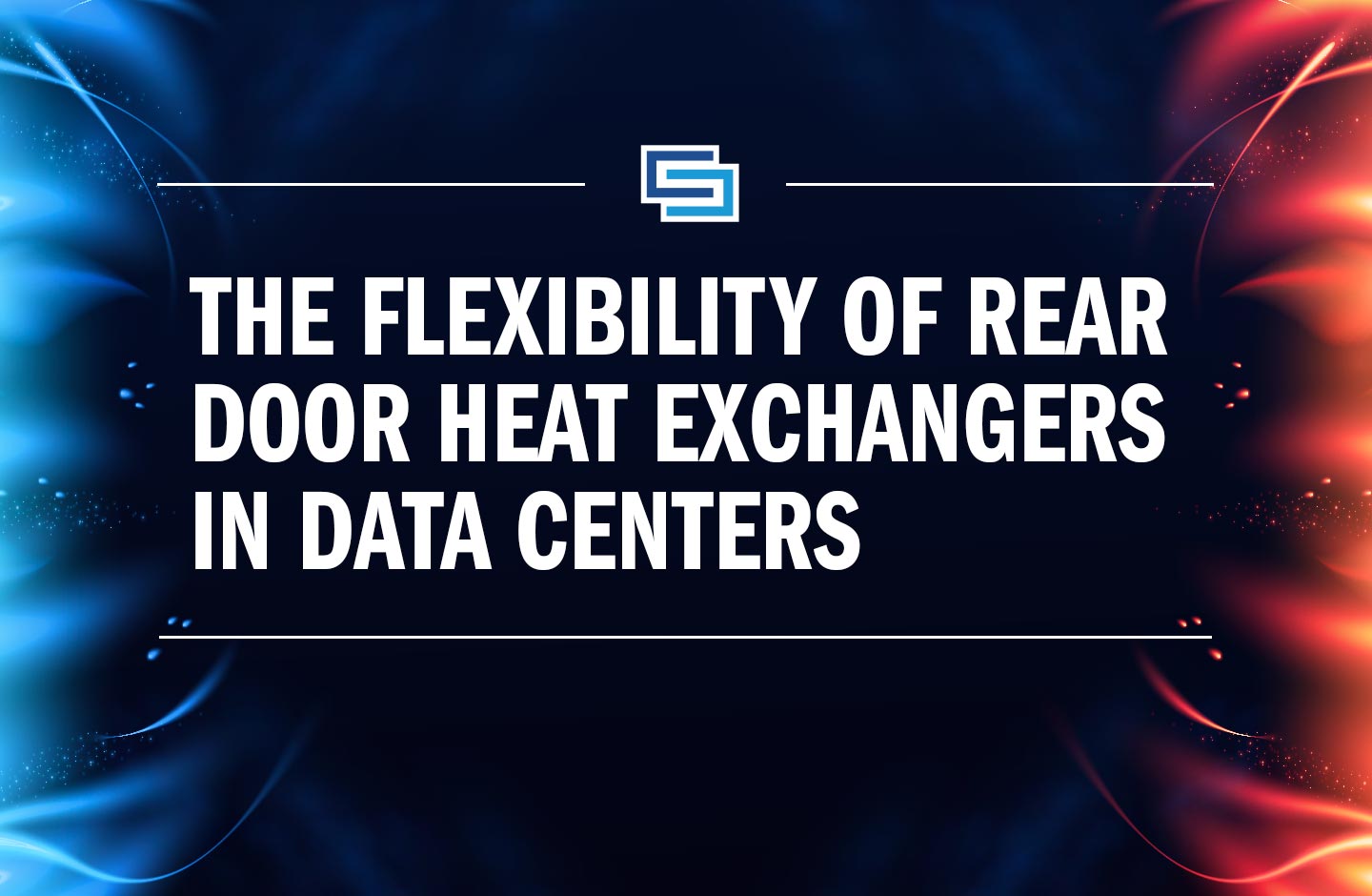The Flexibility of Rear Door Heat Exchangers in Data Centers

Data creation increases daily, and at a compound annual growth rate (CAGR) of 23%, there will be 175 zettabytes of data creation in 2025, according to IDC. Companies must modernize their IT infrastructure and systems to address the demand for increased data storage and processing with increased rack density.
In fact, 57.2% of enterprises expect the average rack density to increase over the next year, and within the next two years, 33.9% of enterprises expect up to a 24% increase while another 17.6% anticipate an increase above 25%. According to 451 Research, the factors driving enterprises to increase rack space densities included new applications (40.3%) and a need for more power capacity (32%).
As the demand for more processing power within the data halls continues, the industry will need to start adapting their cooling methodology to be more flexible and more efficient. This necessity will become even more critical as rack densities start exceeding the capacities of flooded rooms or raised floor distributions with larger deployments. As a result, the industry may be driven towards more water-based solutions due to the increased efficiencies of pumps over fans and the heat transfer coefficient of water over air. An intelligently designed facility would even be flexible enough to support a hybrid approach as end-users start introducing higher density racks as part of their own internal proof of concepts.
Water-based cooling solutions, or liquid cooling, include three options: direct-to-chip, immersion, and water to rack. Direct-to-chip removes about 60-70% of heat rejection from the servers, and while immersion cooling is the most energy efficient method of the three options, it poses the most complications to integrating into existing facilities based on the weight of the immersion tanks and the need for storage/disposal of the fluid. On the other hand, water to rack utilizing rear door heat exchangers (RDHx) achieves up to 100% of heat removal and represents an ideal solution for “hybrid liquid cooling.”
Going Hybrid with Air Chillers and RDHx
High-density racks, featuring more powerful central processing units (CPUs) and graphics processing units (GPUs), produce more heat than a traditional data hall can handle. For racks with densities 20kW or higher, RDHx are low-maintenance, flexible solutions that efficiently manage heat rejection and cooling within high-performing data centers. If a single unit is unavailable due to maintenance or repair, the IT equipment in that rack can still operate efficiently because the whole room is, in effect, the cold aisle, and adjacent racks can generate enough cold air to cool surrounding equipment inputs.
RDHx are categorized into passive and active heat exchangers. Each type is a slim panel that attaches to the back of the cabinet by utilizing a customizable adaptive frame, resulting in up to 14” of additional cabinet depth. While neither delivers liquid directly to the server or chip, both employ coils filled with chilled water to capitalize on the high thermal transfer properties of water and the reduced fan energy by removing the heat closer to the IT equipment source.
Passive RDHx utilize the server fans to push the heated exhaust air across a liquid-filled coil that absorbs the heat before the air is returned to the data hall.
Active RDHx feature additional fans to pull the heated exhaust air across the liquid-filled coil that removes the heat before the air is returned to the data hall.
After the chilled water absorbs the server heat, it journeys back to the chilled water plant to be cooled down and then returned to the data hall to repeat the cycle through the rear door heat exchangers.
Since a cooling system with RDHx cools closer to the source, there is no need for the larger fans used in traditional systems to flood the space with cool air, resulting in less energy usage. RDHx do not require fan wall units, plenum ceilings, or raised floors, making it a straightforward installation. In a cold aisle containment system, containment would still be required for RDHx in a hybrid installation; on the other hand, with a hot aisle containment system, containment would not be required in a hybrid installation. If the entire build was with RDHx, then no containment is required, leading to cost savings in installation.
The Advantages of a Hybrid Cooling System with RDHx
Rear door heat exchangers offer various benefits over traditional air cooling and other types of liquid cooling.
- Heat Removal
RDHx remove 100% of the heat rejection, unlike direct-to-chip liquid cooling, which requires additional fan wall units to assist with the other 30% that is not removed. Subsequently, ceiling plenums and hot and cold aisle containment systems are still necessary for direct-to-chip, resulting in additional cost of piping and infrastructure to get water out to the servers. Since RDHx removes 100% of the heat rejection, it does not require containment, a ceiling plenum, or fan wall units.
- Energy Efficiency
Capitalizing on water’s higher heat capacity, liquid cooling is a more energy efficient method of cooling higher-density racks than traditional air cooling. Additionally, the need for fans is reduced, further decreasing energy consumption, and driving down expenses.
- Processing Capacity
The combination of 100% heat removal and energy efficient cooling establish RDHx as an ideal solution for facilities with rack densities of 20kW and up to 50kW+, allowing hyperscalers and large enterprises to address data demand and growth more easily and effectively.
- Downtime
Since RDHx cool servers completely as well as much closer to the rack, it reduces the risk of overheating equipment and the resulting cost—both financially and strategically—of downtime.
- Space and Installation
RDHx require less additional infrastructure, and thus, consume less space in the data hall and expend less time in the initial installation.
- Flexibility
Perhaps the most compelling advantage of RDHx is its flexibility as it is suitable for 100% liquid cooling as well as hybrid cooling environments. It can be implemented from the start with a new build or added on later in a facility’s life, providing hyperscalers and large enterprises flexibility and room for growth as data increases.
The Stumbling Blocks on RDHx’s Journey to Widespread Adoption
- Cost
Liquid cooling—whether direct to chip, immersion, or rear door heat exchangers—has more upfront capital costs than fan wall units with containment systems. While the initial installation is more expensive, RDHx is also more efficient, aiding equipment performance and reducing energy consumption.
- Leaks
As with any liquid cooling, there is a potential for leaks and subsequent damage to IT equipment. However, RDHx has less risk than the two other types of liquid cooling. With direct-to-chip, if a server fails at any time, the water must be disconnected at that particular server, increasing room for human error of a leak or drip in that moment. In the same situation in an immersion cooling system, the server, submerged in extremely slippery dielectric fluids must be removed; this establishes the opportunity for drips on the floor which pose safety hazards to humans.
Regardless of which type of liquid cooling is deployed, all systems that utilize liquid cooling should include a leak detection and mitigation system. STACK Infrastructure enacts extensive leak detection and mitigation measures, including a prefabricated pipe support for water manifolds, with a transparent drip tray as well as ways to mitigate the risk of pinhole leaks. After four years of operating RDHx with an overhead piping system, STACK is still leak-free.
Scaling for the Future with RDHx
Hyperscalers and large enterprises need to stay ahead of ever-increasing data demand. Liquid cooling enables data center facilities to pack more power into racks, while still operating as efficiently, if not more so, as lower-density racks with traditional air cooling.
The Solutions Engineering team at STACK Infrastructure has been installing rear door heat exchangers and establishing hybrid liquid cooling systems for years. Our in-house mechanical engineering expertise has resulted in 12MW of water to rack technology successfully being installed in both new builds and retro-commissioned live data halls with years of smooth operation.
STACK’s Basis of Design (BoD) data center lays the foundation for flexibility and utilizes future provisions so water to rack can be implemented later if a client does not need it yet, but plans for the rack densities requiring it. Our BoD runs warmer chilled water temperatures, so a cooling distribution unit (CDU) may not be required, saving capital expenditures for the client. Since our BoD includes hot aisle containment, direct-to-chip cooling can also be integrated into our system.
As data grows and the need for higher density racks increases, rear door heat exchangers will continue to rise in popularity, and STACK’s platform is ready to adapt to those needs.
By Adam Michaelis, PE, Director, Solutions Engineer at STACK Infrastructure
May 4, 2022




